#robots from 2003
Explore tagged Tumblr posts
Text

Wakamaru by Mitsubishi (2003)
#robotics#robots#wheeled robots#dual arm manipulators#companion robots#00s#00s robots#2003#robots from 2003#japan#japanese robots#mitsubishi#mitsubishi heavy industries
0 notes
Text
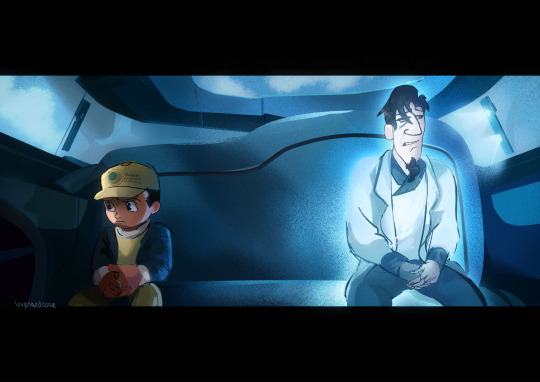
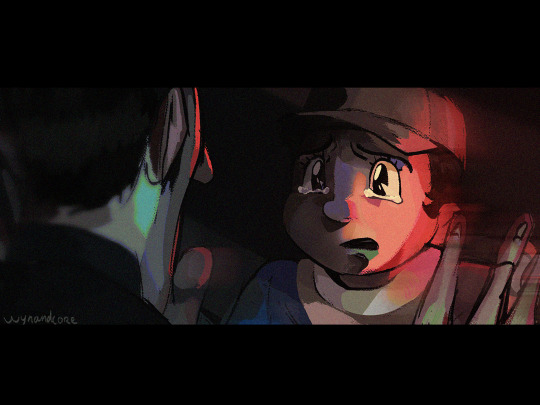

Watched Astro Boy 2009 and I wanted to see it with a more accurate Astro/Toby design
#watched the movie for the first time just a week ago. five episodes into the 2003 anime and I love it#I still like what 2009 tries to tackle about acceptance n grief and Atom not knowing he’s a robot at first. like that’s cool#but it just doesn’t grab onto that hard enough#same goes w the art direction it’s just a little too generic. edging on something interesting but it doesn’t take that risk#whatever I still like the 2009 movie for what it Tries to do#actually I still love 2009 don’t tell anyone#art tag#astro boy#astro boy 2003#astro boy 2009#tetsuwan atom#I didn’t change tenma much bc this tenma is sooooo different from what I’m seeing so far of 2003 tenma. idk could change#umataro tenma#dr tenma
304 notes
·
View notes
Text
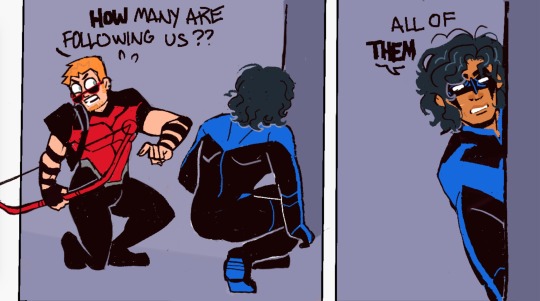

Another old post... this is a badly formatted comic but I wanted to finish it so it wouldn't stay a coloured sketch anymore :0
#dickroy#roydick#dccomics#dick grayson#roy harper#that grace panel made me watch this movie#its gr8#thnks winnick#the movie is butch cassidy and the sundance kid 1969#comic is outsiders 2003#read it if you havent already its got queer people (real)#and a robot#re-posted from xwitter#nightwing#arsenal#ive always wondered if anyone calls them nightarse#it sounds absolutely cursed#arsewing doesn't get any better either#can be platonic#dick & roy#dick/roy
855 notes
·
View notes
Text
Ok so random thought. What if the rise turtles fed up with being treated as ‘odd’ by a couple of the other iterations, decided to pretend to be a ‘new’ iteration for a night. Just to see how’d they react.
Leo, wrapping his arms around his bros: “Say. I got an idea~. That’ll REALLY tell us what they think of us.”
*says idea*
Mikey grabs Donnie’s bandanna and wears it. “Ohhhh! I get to show off my psychology degree!” Bouncing on his heels.
*he will also be able to stretch this delusion on account that he knows how to weld and has helped Donnie make things.
“OH-HO HO!” Donnie grabs Raph’s bandanna excitedly, finger gun pose, “I’m gonna be the best RAPH ever!” Leans forward fists to his sides looking FERAL.
Leo grabs Mikey’s bandanna, posing, “Not bad~. I can make this work~.” Smiling coyly, eyes shut, sparkles.
*he will be Extra.
“Mmm… I don’t think Raph likes how the mask doesn’t cover my whole head.” Raph wearing Leo’s blue mask scratches his head as his brow furrow in concern.
Donnie waved his hand dismissively, “Don’t worry. I can make new adjusted ones for us.”
“Good! Cause I wanted my mask tails longer!” Leo called.
“We still have to look unrecognizable however.” Donnie typing on his wrist. “So maybe we should leave certain things. I —unfortunately— should forgo my eyebrows.”
Leo: “I still don’t know how you think you’re gonna pull off Raph! That voice is a dead-nerd give away!”
Donnie grabbed his chin, “Mmm… You may offer a fair point. Perhaps a ‘cool, silent bad boy’ type would fit me!” Grinning. “Practicing a deeper voice would help.”
His eyebrows perked up. “Raph should be fine as long as he stops speaking in the 3rd person.” Raph laughs nervously(?).
*Donnie will later be showing up a motorcycle and way too cool clothes.
“But what about Raph’s size?” Mikey leaned in worriedly
“Yeah what about my height?” Rafa repeated.
“Come to think of it. It is kinda dead-end give away.” Leo grabbed his chin.
“Hmm.” Donnie thought, “I could probably invent a shrink way, or something to temporarily change your build.”
*This may or may not go wrong later. Raph will still have his spiked shell. Possibly a much thinner build and tail (if we want) if we go this route.
*though it would be fun imagining them try to dress up Raph convincingly as his size. Maybe using Mikey’s craft skills. Other alternatives would be Donnie making a robot Raph speaks through. And a poorly constructed dummy Raph speaks for from behind a corner. Actually that robot might be a solid idea—
In the end they all look different enough, try speaking in (slightly) different voices boarding on bad.
?Mikey probably painted their skin to look darker/more consistent (more like Donnie’s blue-green skin maybe??)
But all in all it’s just believable enough.
Feel free to use I guess. I don’t think I have time to draw it.
Edit: My Tags

#rottmnt#rise of the tmnt#rise leo#rise donnie#rise mikey#rise raph#rise of the teenage mutant ninja turtles#2003 tmnt#2012 tmnt#the other iterations aren’t actually that mean but between the tense conflicts the misunderstandings the fights (bros fight)#it’s interesting to think they’d try this#and it ends like a real episode where they get closer/understand eachother#Or…#robot breaks other iterations are horrified#Leo: ‘You DO! Care about us!’ *grips his hands#‘now we can all come together and be closer as brothers.’#*stunned stares#*furious yelling from all of them*
69 notes
·
View notes
Text
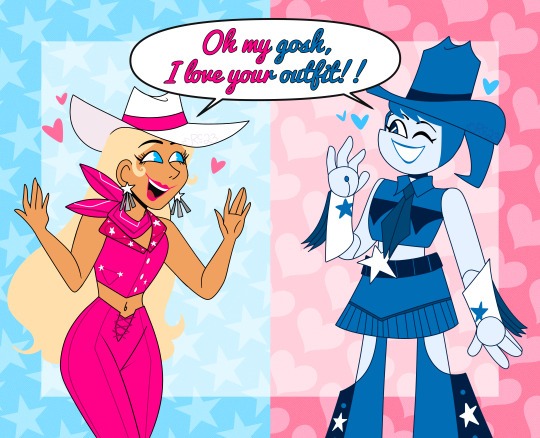
The two CEO Girlbosses of my childhood finally holding a meeting on how to maximize their joint slay. Yeehaw! 🤠💖
#mlaatr#my life as a teenage robot#jenny xj9#jenny wakeman#barbie#barbie movie#barbie 2023#stereotypical barbie#kei's average art tag#I love realizing that as an artist I can literally draw whatever I want :n)#granted THE barbie of my childhood was the Swan Lake Barbie from 2003 but w/e yeehaw
207 notes
·
View notes
Text

#my art#art#aquarelle#aquarel drawing#watercolourpainting#robot from anime#robot#astro boy#astro 2003#denkou
18 notes
·
View notes
Text


Well now I’m just watching Astro Boy (2003) for the fun of it. Doing tarot cards is always fun because they’ve fundamentally already been traced a billion times already.
#Klaus/Claus got a free ride into my brain#because I’d been doing some random doodles thinking about the prospect of Gesicht’s replacement#if your starting from scratch anyway how do you try to avoid all the ‘problems’ the first had#the fundemental question being would said ‘problems’ get written up on paper as him being too human or not human enough#so Claus being a detective robot who’s whole issue is that he acts way too human for his department’s taste is a fun wrinkle to the day#that isn’t to say Claus doesn’t have his own merits for brain privileges.#he absolutely does.#but honeslty I think if I go into that tumblr will make this as mature too#my art#Astro Boy (2003)
8 notes
·
View notes
Text

15.04.24
#journal#YIPPEE!#i did not attend kidz bop never stop tour btw. i just picked up this leaflet a while ago because it was funny and i knew i could use it in a#collage at some point....#um materials used here are quite varied but to name a few. leaflet advertising shrewsbury festival. comic shop receipt. token card from a#beer festival. packaging from a figure. easter chick from the most essential item an artist can own: crafts beautiful magazine 2003.#the robot doodles are not mine they are from the festival leaflet#im kind of obsessed with qr codes to be honest like they're ugly and vile and too prevalent in our world but also because they're literally#on everything they're a good thing to collect i guess. a reflection of our times
3 notes
·
View notes
Text
please do yourself a favor and relisten to albums you listened to once years ago and didn't like at the time
#me 5 years ago: hmmm ima robot (2003) doesn't do much for me. i like 12=3 and what are we made from and not much else.#me relistening to it after finding it used at the record store for $5 and saying eh fuck it and grabbing it: HOOOOOLY SHITTTTTT#talking
2 notes
·
View notes
Text

Keepon by Hideki Kozima (2003)
#robotics#robots#companion robots#00s#00s robots#2003#robots from 2003#japan#japanese robots#hideki kozima
0 notes
Text
Three AI insights for hard-charging, future-oriented smartypantses
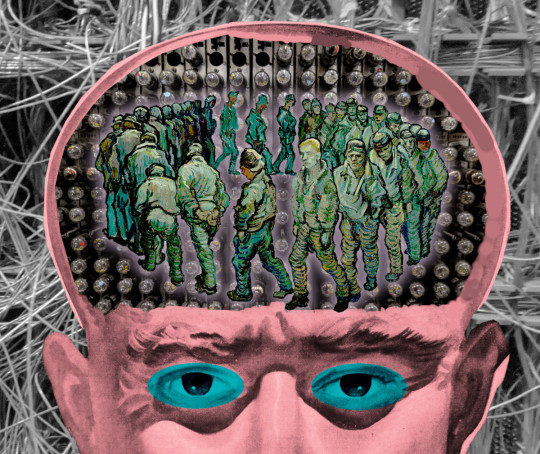
MERE HOURS REMAIN for the Kickstarter for the audiobook for The Bezzle, the sequel to Red Team Blues, narrated by @wilwheaton! You can pre-order the audiobook and ebook, DRM free, as well as the hardcover, signed or unsigned. There’s also bundles with Red Team Blues in ebook, audio or paperback.

Living in the age of AI hype makes demands on all of us to come up with smartypants prognostications about how AI is about to change everything forever, and wow, it's pretty amazing, huh?
AI pitchmen don't make it easy. They like to pile on the cognitive dissonance and demand that we all somehow resolve it. This is a thing cult leaders do, too – tell blatant and obvious lies to their followers. When a cult follower repeats the lie to others, they are demonstrating their loyalty, both to the leader and to themselves.
Over and over, the claims of AI pitchmen turn out to be blatant lies. This has been the case since at least the age of the Mechanical Turk, the 18th chess-playing automaton that was actually just a chess player crammed into the base of an elaborate puppet that was exhibited as an autonomous, intelligent robot.
The most prominent Mechanical Turk huckster is Elon Musk, who habitually, blatantly and repeatedly lies about AI. He's been promising "full self driving" Telsas in "one to two years" for more than a decade. Periodically, he'll "demonstrate" a car that's in full-self driving mode – which then turns out to be canned, recorded demo:
https://www.reuters.com/technology/tesla-video-promoting-self-driving-was-staged-engineer-testifies-2023-01-17/
Musk even trotted an autonomous, humanoid robot on-stage at an investor presentation, failing to mention that this mechanical marvel was just a person in a robot suit:
https://www.siliconrepublic.com/machines/elon-musk-tesla-robot-optimus-ai
Now, Musk has announced that his junk-science neural interface company, Neuralink, has made the leap to implanting neural interface chips in a human brain. As Joan Westenberg writes, the press have repeated this claim as presumptively true, despite its wild implausibility:
https://joanwestenberg.com/blog/elon-musk-lies
Neuralink, after all, is a company notorious for mutilating primates in pursuit of showy, meaningless demos:
https://www.wired.com/story/elon-musk-pcrm-neuralink-monkey-deaths/
I'm perfectly willing to believe that Musk would risk someone else's life to help him with this nonsense, because he doesn't see other people as real and deserving of compassion or empathy. But he's also profoundly lazy and is accustomed to a world that unquestioningly swallows his most outlandish pronouncements, so Occam's Razor dictates that the most likely explanation here is that he just made it up.
The odds that there's a human being beta-testing Musk's neural interface with the only brain they will ever have aren't zero. But I give it the same odds as the Raelians' claim to have cloned a human being:
https://edition.cnn.com/2003/ALLPOLITICS/01/03/cf.opinion.rael/
The human-in-a-robot-suit gambit is everywhere in AI hype. Cruise, GM's disgraced "robot taxi" company, had 1.5 remote operators for every one of the cars on the road. They used AI to replace a single, low-waged driver with 1.5 high-waged, specialized technicians. Truly, it was a marvel.
Globalization is key to maintaining the guy-in-a-robot-suit phenomenon. Globalization gives AI pitchmen access to millions of low-waged workers who can pretend to be software programs, allowing us to pretend to have transcended the capitalism's exploitation trap. This is also a very old pattern – just a couple decades after the Mechanical Turk toured Europe, Thomas Jefferson returned from the continent with the dumbwaiter. Jefferson refined and installed these marvels, announcing to his dinner guests that they allowed him to replace his "servants" (that is, his slaves). Dumbwaiters don't replace slaves, of course – they just keep them out of sight:
https://www.stuartmcmillen.com/blog/behind-the-dumbwaiter/
So much AI turns out to be low-waged people in a call center in the Global South pretending to be robots that Indian techies have a joke about it: "AI stands for 'absent Indian'":
https://pluralistic.net/2024/01/29/pay-no-attention/#to-the-little-man-behind-the-curtain
A reader wrote to me this week. They're a multi-decade veteran of Amazon who had a fascinating tale about the launch of Amazon Go, the "fully automated" Amazon retail outlets that let you wander around, pick up goods and walk out again, while AI-enabled cameras totted up the goods in your basket and charged your card for them.
According to this reader, the AI cameras didn't work any better than Tesla's full-self driving mode, and had to be backstopped by a minimum of three camera operators in an Indian call center, "so that there could be a quorum system for deciding on a customer's activity – three autopilots good, two autopilots bad."
Amazon got a ton of press from the launch of the Amazon Go stores. A lot of it was very favorable, of course: Mister Market is insatiably horny for firing human beings and replacing them with robots, so any announcement that you've got a human-replacing robot is a surefire way to make Line Go Up. But there was also plenty of critical press about this – pieces that took Amazon to task for replacing human beings with robots.
What was missing from the criticism? Articles that said that Amazon was probably lying about its robots, that it had replaced low-waged clerks in the USA with even-lower-waged camera-jockeys in India.
Which is a shame, because that criticism would have hit Amazon where it hurts, right there in the ole Line Go Up. Amazon's stock price boost off the back of the Amazon Go announcements represented the market's bet that Amazon would evert out of cyberspace and fill all of our physical retail corridors with monopolistic robot stores, moated with IP that prevented other retailers from similarly slashing their wage bills. That unbridgeable moat would guarantee Amazon generations of monopoly rents, which it would share with any shareholders who piled into the stock at that moment.
See the difference? Criticize Amazon for its devastatingly effective automation and you help Amazon sell stock to suckers, which makes Amazon executives richer. Criticize Amazon for lying about its automation, and you clobber the personal net worth of the executives who spun up this lie, because their portfolios are full of Amazon stock:
https://sts-news.medium.com/youre-doing-it-wrong-notes-on-criticism-and-technology-hype-18b08b4307e5
Amazon Go didn't go. The hundreds of Amazon Go stores we were promised never materialized. There's an embarrassing rump of 25 of these things still around, which will doubtless be quietly shuttered in the years to come. But Amazon Go wasn't a failure. It allowed its architects to pocket massive capital gains on the way to building generational wealth and establishing a new permanent aristocracy of habitual bullshitters dressed up as high-tech wizards.
"Wizard" is the right word for it. The high-tech sector pretends to be science fiction, but it's usually fantasy. For a generation, America's largest tech firms peddled the dream of imminently establishing colonies on distant worlds or even traveling to other solar systems, something that is still so far in our future that it might well never come to pass:
https://pluralistic.net/2024/01/09/astrobezzle/#send-robots-instead
During the Space Age, we got the same kind of performative bullshit. On The Well David Gans mentioned hearing a promo on SiriusXM for a radio show with "the first AI co-host." To this, Craig L Maudlin replied, "Reminds me of fins on automobiles."
Yup, that's exactly it. An AI radio co-host is to artificial intelligence as a Cadillac Eldorado Biaritz tail-fin is to interstellar rocketry.


Back the Kickstarter for the audiobook of The Bezzle here!

If you’d like an essay-formatted version of this post to read or share, here’s a link to it on pluralistic.net, my surveillance-free, ad-free, tracker-free blog:
https://pluralistic.net/2024/01/31/neural-interface-beta-tester/#tailfins
#pluralistic#elon musk#neuralink#potemkin ai#neural interface beta-tester#full self driving#mechanical turks#ai#amazon#amazon go#clm#joan westenberg
1K notes
·
View notes
Text
Deaths of Jason Todd
Part of the Batfam Death Project.
Jason has died five times. There are also a further three times when he might have arguably died. I have not found any instances of Jason visiting the afterlife without being dead.
Total time dead: 6 months, give or take a few days.
Verifiable deaths
1. Killed by the Joker in Ethiopia (Batman 1:427–428, 1988)
As we all know, Jason was killed by the Joker (Batman 1:427–428, 1988).

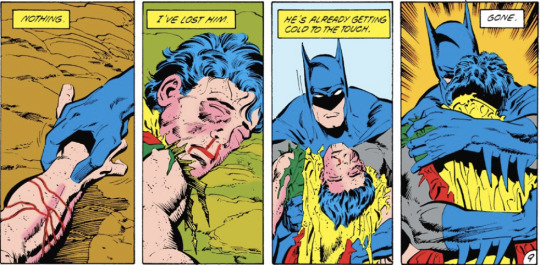
He went to Heaven (Green Arrow 3:7, 2001).

He woke up in his coffin six months later because something something Superboy Prime (Batman Annual 25, 2006),


and was restored from catatonia by Talia via the Lazarus Pit (also Batman Annual 25).


Time dead: probably around six months, but it’s complicated.
2. Killed by Batman to release him from demonic possession (Trinity 2:15, 2017)
Circe and Ra’s al Ghul worked together to get the Outlaws (Jason, Artemis, and Bizzaro) possessed by demons from the Pandora Pits intent on sacrificing Batman, Wonder Woman, and Superman. Bruce injected a possessed Jason with potassium chloride to kill him, forcing the demon out, then restarted his heart by defibrillation.

(This comic also features Superman and Constantine climbing through a portal to hell in possessed!Jason’s mouth.)
Time dead: a minute or so.
3. Beaten to death by groblins (Dark Nights: Death Metal 7, 2021)
Jason, along with other members of the Batfamily, was overwhelmed by a swarm of ‘groblins’: mindless evil Jokerised Robins invading from the Dark Multiverse, led by the Robin King (an evil child Bruce Robin).

Shortly after that he was raised as a zombie (missing an arm) by Black Lantern Batman to continue the fight.
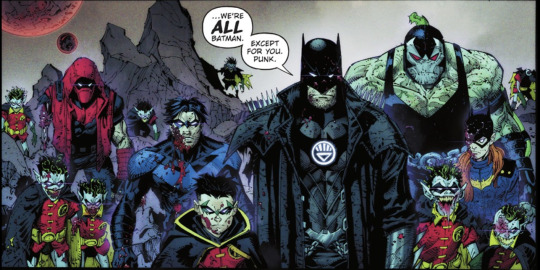
Jason was restored to proper life when Wonder Woman, powered by the determination of her friends, defeated the evil Batman Who Laughs and persuaded the gods to remake the multiverse as it was before the evil universes invaded the good ones.
Time dead: somewhere from quarter of an hour to an hour? Or perhaps a lot longer, if it took longer to rebuild the world. It’s always a little tricky to be sure when world remakes are involved.
4. Shot in the back by zombie Deadshot (Task Force Z 3–4, 2022)
Jason joined a team of zombies called Task Force Z, an organisation run by Harvey Dent with questionably legitimate government backing and copious quantities of Lazarus resin to bring them back every time they died. He was sent to recruit Deadshot by raising him from the dead. Apparently some fool buried Deadshot’s wrist guns with him, because the first thing Deadshot did on being resurrected was to shoot Jason in the back.

Jason was rushed back to the organisation’s facility but flatlined on the operating table.

He was revived by an injection of Lazarus resin into the brain (or possibly just the outer ear? picture is unclear), administered by one of the staff of the questionably legitimate facility.

Time dead: less than a minute.
5. Killed by the Batman of Zur-En-Arrh (Batman 3:148, 2024)
Batman’s dissociation backup personality, called Zur-En-Arrh, turned evil and downloaded itself into a robot. It fought Batman and Jason jumped in to save him; Zur took him out with a stong uppercut to the jaw, smashing his facemask, and threw him down hard, which broke his neck and killed him.

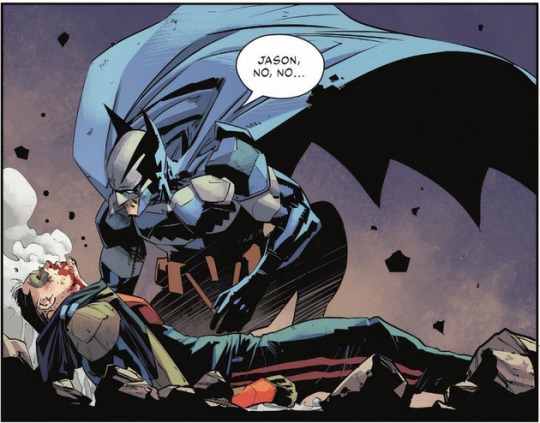

This was a setup by Bruce and Jason: Jason was wearing a special suit that injected him with Lazarus resin, so he was revived almost instantly, while having killed someone caused Zur-En-Arrh to crash.
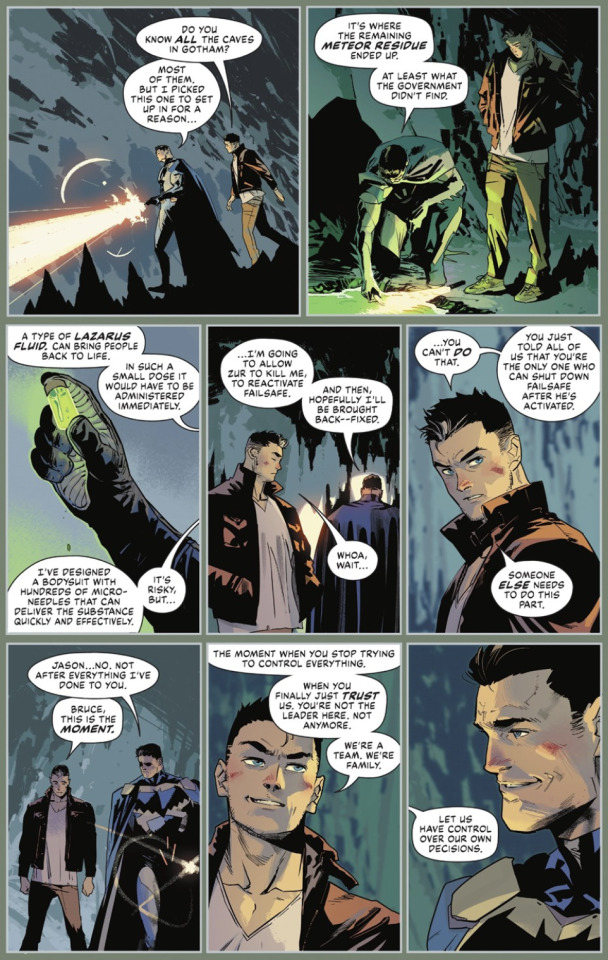

Time dead: a few seconds.
Inferrable and arguable deaths
1. Arguably died when Joker takes over the world (Emperor Joker, 2000)
After the Joker stole reality-altering powers from Mxyzptlk and remade the universe to his liking, he placed Jason’s rotting corpse alongside Dick’s and Tim’s for a macabre poker game.

Emperor Joker was published in 2000, well before Jason was revealed to be alive in the Under the Hood storyline, published in 2006 (and later retconned to have been present in the Hush storyline in 2003), and absolutely before any writer had conceived of bringing him back to life. But given that he is supposed to have been shambling around as a zombie and then getting assassin training for a long while before that, taking the retcons into account he ought to have been alive at the time of Emperor Joker.
So while at the time of writing Jason was intended to be continuously dead, after the retcons we have to say that Joker killed Jason again, perhaps even unknowingly, to put him in his poker game.
After Joker was defeated, Mr Mxyzptlk, with Spectre!Hal’s guidance, restored the world to its previous state, which presumably also involved restoring Jason to life again.
Time dead: it’s complicated.
2. Perhaps dies in the confrontation with Bruce involving the Joker (Batman 1:650, 2006)
When he returned to Gotham as the Red Hood, Jason engineered a confrontation between himself, Batman, and the Joker. Batman ended up throwing a batarang which clipped his shoulder. (Jason had previously in this story monologued about how shoulder wounds can kill quickly from blood loss but are easily treated if you’re quick.) Then the Joker shot the explosives Jason had set and the building blew up.
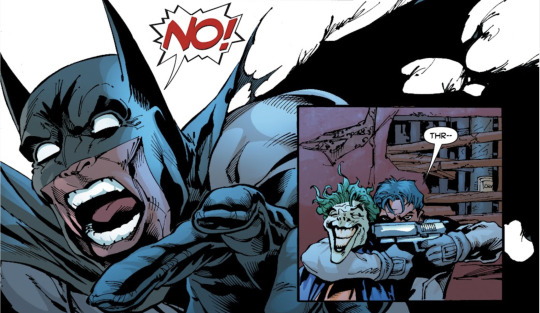
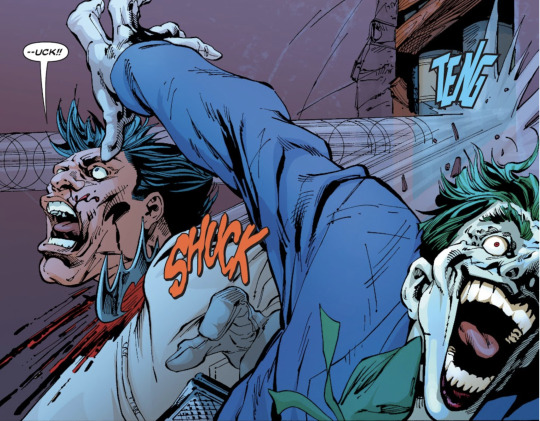
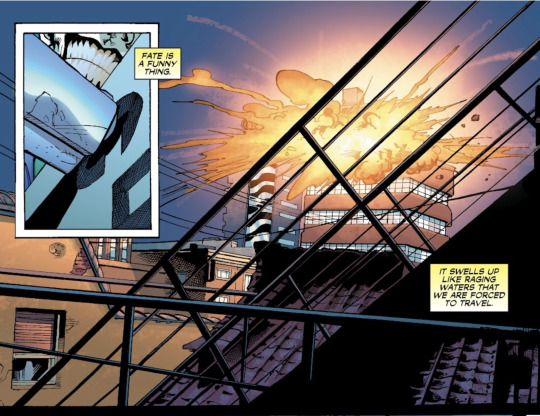
Batman presumably assumes Jason is dead (Jason and Joker were right on top of a large pile of explosives – in fact, it’s pretty amazing even Bruce, who was standing a few feet away, managed to get out). So no-one is around to rescue and treat Jason. But Jason returns later with no explanation of how he survived. Either he’s returned from the dead again or he is supernaturally good at not dying.
Then again, the Joker survived too, so who knows?
Time dead: unknown, if any.
3. Perhaps dies when Dick throws him off a bridge into Gotham River (Batman: Battle for the Cowl 3, 2009)
After Jason nearly killed both Tim and Damian, during the Battle for the Cowl while Bruce was lost in time, Dick confronted him in a battle which ended up on top of a train going over a high bridge. Dick knocked Jason off the train, and they ended up on the bridge with Jason dangling off the edge.
Dick did the whole ‘Take my hand’ thing and Jason said “I’ll be seeing you sooner than you think,” before letting go and dropping into the water from a great height.
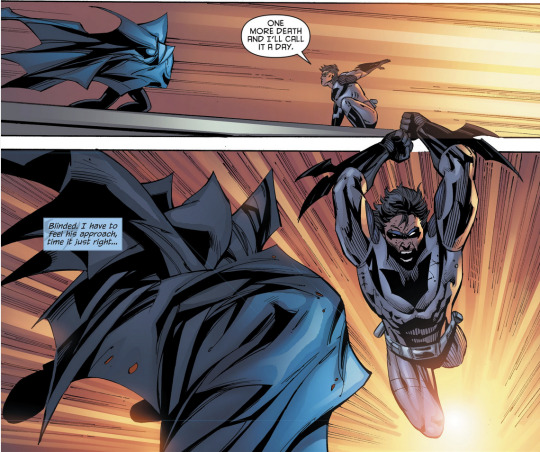


This suggests either Jason knows he’s going to come back from the dead or Jason thinks Dick is going to die soon. Dick definitely reacts as if he thinks Jason is dead, and Dick probably has a pretty generous idea of what’s survivable when it comes to heights.
Again, Jason returns later with no explanation.
Time dead: unknown, if any.
Batfam Death Project Masterpost
#batfam death project#deaths of jason todd#jason todd#corpses#blood and gore#I will edit this post if I find any further deaths for Jason
159 notes
·
View notes
Text
one of my favorite things about TMNT 2003 is how it’s very much set in a comic book universe. obviously the show pulls a lot of inspiration from the early mirage comics and that’s so clear in how stories just sort of stack on top of each other
there’s superheroes and a diet Justice League, there’s an ancient extinct civilization that just crops up occasionally; we have all sorts of aliens and robots happening. magic and alternate dimensions and time travel happen all the time and no one bats an eye
I just find it very fun how much capital L Lore gets thrown around as the show goes on. makes trying to explain anything that’s happening very convoluted
331 notes
·
View notes
Text
A TMNT Crossover fanfic where it’s just the 2012! TMNT boys trying to explain their Bishop to other versions of themselves.
Imagine the 2003 turtles hearing about a version of Bishop that’s actually an alien utrom that saved Mikey from vivisection.
Imagine the rise turtles having to hear about how he’s a “good kraang” and that he’s only a foot tall outside his robot suit.
Imagine the TOTTMNT boys trying to comprehend that all of the above while trying to wrap their heads around the fact that, somehow, a version of Bishop willingly worked with mutants with the goal to prevent the destruction of humanity.
#I was gonna include the 1987 TMNT boys but let’s face it they would not be phased#tmnt#tmnt crossover#rise of the tmnt#rottmnt#tottmnt#tmnt 2012#tmnt 2003#2012 mikey#2012 donnie#2012 raph#2012 leo#2003 leo#2003 raph#2003 mikey#2003 donnie#tottmnt leo#tottmnt raph#tottmnt mikey#tottmnt donnie#rise donnie#rise raph#rise mikey#rise leo#rottmnt raph#rottmnt leo#rottmnt mikey#rottmnt donnie#rise of the teenage mutant ninja turtles#tales of the teenage mutant ninja turtles
188 notes
·
View notes
Note

The steel battalion controller could fix me. Some company needs to make specialty mech controllers so i dont have to spend £350 on 2003 hardware (so i can spend £350 on 2025 hardware).
Mech game Controllers: Solving the unsolvable
I have put so much time into thinking about this and you've basically asked the perfect question.
I think there are really complex and important questions that nobody really has a good robust answer to but also that nobody is really asking those big questions in the first place either, so we're stuck on this issue.
My take is I genuinely think if we want big mecha controllers we have to think about this stuff deeply and profoundly. Like, why we need them and what they're for.
So… This has been tried many times.
NOK or NextOfKin Creatives did try this.
The Mek-Fu lopped horribly, and I was absoloutely fascinated by this at the time and wanted to understand exactly why it had failed. I think we must learn from this failure, so we don't make the same mistakes again.
The lesson I took from Mek-Fu was this: it didn't take because players had nothing to use it in where it was the best fit.
What does this mean?
1) For other games in the real world, it was inferior to keyboard and mouse in games which do not simulate a vehicle. 2) The design wasn't trying to meet some sort of pre-existing need from other games. 3) Steel Battalion emulation did not exist meaningfully yet, and in turn no equivalent game existed on the PC platform which would need it.
Therefor: There was no special environment where its employment made the best sense.
It had nowhere to excel and thrive.
So where have specialty controllers existed, and thrived?
Digital Combat Sim (DCS)
Star Citizen
Euro Truck Simulator
Farming Simulator
What do they all have in common?
They all have robust modding tools for user-created content
They all have some form of social experience or multiplayer
They all are highly accessible (PC, and are controller agnostic*)
They are all sandboxes in some capacity and let users find their own fun.
No mech game which exists at time of writing meets all these terms that I know of.
So what do these controllers look like?
In the case of real vehicles, you can simply ape the real vehicle 1:1, but for fictional vehicles, something special happens -- you see people approach and try to solve the problem in many different ways.
You see, control design in any area exists to solve a problem. The Mek Fu (a response to the VT controller) was a solution looking for a problem, and no problem existed.
From this, we learn that for specialty mech controllers to exist, you first need specialty mech games. Steel Battallion is limited, because it won't run on general hardware and doesn't network or mod easily so it isn't a good fit for this because it makes the game inaccessible and limited.
Let's actually think about the SB controller for a bit:
Steel Battalion approaches its problem from the standpoint of a robot. You might not realize this but a VT or Vertical Tank intentionally controls very similarly to a tractor.
It is influenced by a real thing. I know that sounds absurd, but let me show you what a modern tractor's task control console looks like:
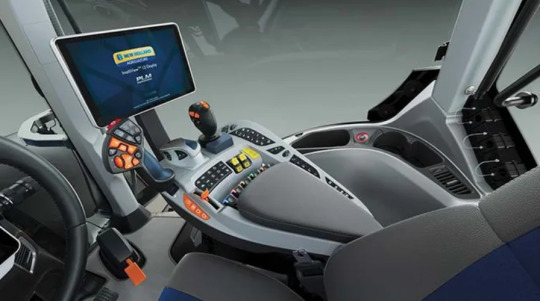
Yeah, not what any of us would have expected.
If you wanna be a mech pilot in 2025, go drive a tractor. I'm not kidding.
Once you're on the field, your hands aren't on the wheel, they're on this thing:
The big stick controls the course in the computer, the little one controls your tool, the many buttons toggle states (or what the little stick is currently triggering) and through these inputs you drive the tractor.
Steel Battalion is very fun, but it won't hold your attention for more than around 100 hours unless you're a real freak about tractors and just don't know it yet.
What's more, Steel Batallion isn't playable to anybody without the controller which limits how many people will be playing it and it isn't social or moddable like the successful games we talked about earlier.
Okay, so what can we do about this?
I think the one feature here that nobody talks about is that of input-agnosticism: The ability to bind your own inputs to something in the game (directly or indirectly through some middle thing) and get good results… But not in some hugely "okay bind 100 things using our controller, or use a keyboard and mouse" binary.
The binary is still not input-agnosticism, and it still will not work.
It has to be granular.
Input agnosticism results in controller agnosticism:
You can bind as much or as little as you want, and you can pass features you don't want to bind directly to a helper subsystem middle-man like an assistant or instructor which will perform limited tasks for you - while you provide the helpers context by telling them which of a limited set of goals you want to achieve.
Say, face a target, or a direction, or aim at a thing. It saves you mental time, though if you did it manually you might get better results (incentivising you towards experimenting in that direction).
Let's touch on why controller agnostic design is really what's needed here, and why its important:
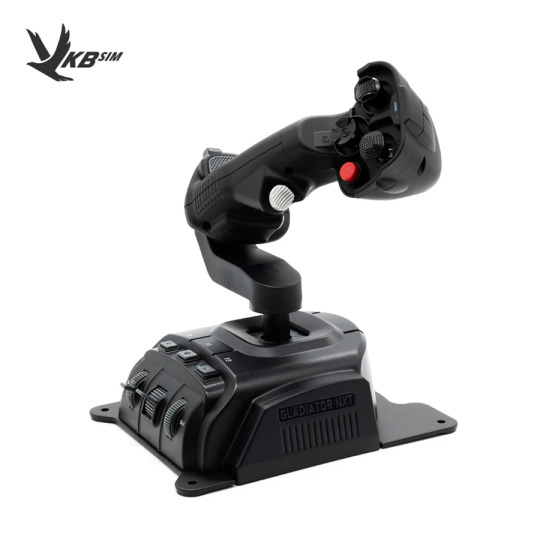
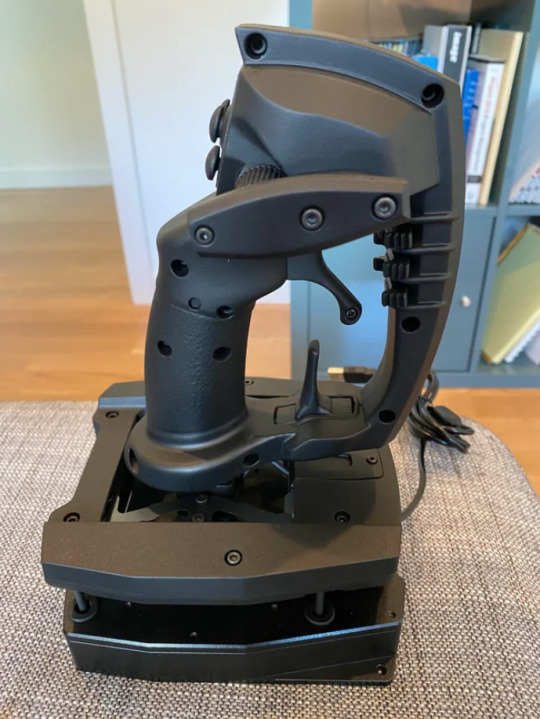
This is the omnithrottle, and and this is the Sublight Dynamics 6dof joystick.
The Omnithrottle tries to solve 6dof throttle management by adding an extra piece to a joystick at the bottom, turning the yaw z-axis-twist of the stick into a sort of vertical axis for direct up and down movement, ascending and descending.
The Sublight Dynamics 6dof joystick combines all six axis into a single device, and is an interesting experiment. I particularly like the puck switches ahead of the user's fingers, inspired likely by Evangelion which in turn was inspired by Sol Bianca's use of them.
We got great lessons in human factors for space dogfighting from both:
The omnithrottle produces huge fatigue if you use it in coupled mode (software assisted flight), because you have to hold the joystick base forward, fighting the springs. This is fine in decoupled mode (where you coast under newtonian force) but not everybody uses it. Likewise, if you remove that spring, you lose fine movement because you can no longer feel where the middle is anymore.
The SD6DOF creates a conflict in Fitt's law (speed and precision are enemies of each-other, and to get both you need a tool in the middle to help you) where some precision is lost due to the same muscles needing to drive more axis at once.
These are both many years old now, and over time we've seen many many solutions to this problem flop.
Well, VKB announced the Space Throttle Grip a few days ago, which rethinks the distribution of axis and combines the best features of both.
youtube
The key thing is, this is an evolutionary space with competing ideas. A healthy ecosystem.
And its only possible because the game's inputs are controller agnostic.
This doesn't just mean that it'll let you bind any input device directly to things, but that there are multiple ways to achieve your desired outcomes even on the software side with the helper middleman we talked about (in this case, coupling modes).
Does your machine turn to face an arbitrary vector which is the thing you actually steer or select (Warthunder)? Do you have direct input control? Do you haven an autopilot?
Here's a lecture by F22 Raptor test-pilot Randy Gordon talking about some of this stuff, giving you a frame of reference with a real vehicle which exists.
youtube
When you can pick between those goals them, you have what's called "a software" in human factors. Your two grips become arbitrary and are now called inceptors.
The software drives the machine, and you drive the software. You can override the software and provide a manual input, but the other elements you are not overriding will try to compensate to maintain a desired state. If you know how to manipulate this, it means you only need a small number of axis to achieve a very complex control action.
A great example is how long you hold the A-button in Mario changes how much power his jump has. The action is a versatile verb.
Imagine a person balancing. If their goal is to stay upright, and I push them, they translate across the ground and try to stay the right way up, turning that push force into horizontal force. They are following an instruction: remain upright.
If I make that person carry a very heavy thing, they compensate their body's balance accordingly. If I then use my finger and tell them to act as if I am pushing them with that gentle motion, they will respond but if they go too far they can say "hey, don't do that, I'll drop the heavy thing!" and ignore my pushing instruction -- because my directive telling them to remain upright superseded it.
We need to think of mecha in terms like these, and to do mecha, we need to make a standard of accessible rules like this which input devices can talk to via axis and buttons, with lots of middlemen.
Absolute (mouse-like) and relative (stick like) and accumiulated (driving a mouse with a stick by having a variable over time) and blended (driving a car with a d-pad with a simulated wheel that wants to return to zero all the time, replicating a stick) inputs must be middle-modes processing and digesting inputs in these ways. Curves matter. Biases and preferences must be accounted for.
This means finally solving "how" the giant robot works in software (even if its a design conceit), and then having systems which poke at the "how" to bias it in a direction toward an outcome.
My favourite version of this is a deliberately clumsy mech-game called Robot Alchemic Drive (RAD for short).
youtube
Playable on a regular PS2 controller, the triggers and bumpers drive the legs like a tank. The sticks drive the arms.
The robot's body has physics. You are controlling a thing.
There are no helpers to correct your motions other than when the robot stands up and to keep it upright (its otherwise 100% manual, playing back motion planning which gets fed into the physics) but yes, there is a simulated body here.
With helpers, this could get faster and way, way more fluent.
So how might these "helpers" in software work?
Think for example of how a body in motion continues to move. With a robot in a vacuum like space, you'd continue indefinitely. That's hard to control.
Do you automatically slow down and fake aerodynamic drag axially with your boosters to allow curved trajectories and soft stopping with a motion-control-decoupling-mode (as Star Citizen does), or do you have a breaking system a user can activate on a pedal or trigger, to apply those forces on different axis when they want them?
youtube
What are those axis bound to, the pelvis, the thorax, the head, the synthetic vision 3rd person camera?
These are really complicated questions, and this is just about how we make a vehicle come to a stop!
Now this might seem niche, but this exact same kind of thought also applies to how a robot balances, and how it digs its feet into the ground, creating torque or not situationally.
This isn't just fine grained motion like "moving our legs manually", but how and when we apply breaking force on the ground.
Do we apply it when we let go of the left stick?
Does the left stick prescribe a preferred velocity?
Does it prescribe input forces?
Do we change between these situationally, or maybe with a button?
Its important to think about these things.
"You're making this too complex!!"
"But why would we do this? What is the value? People are playing Armored Core 6 with a HOTAS!!"
Yeah, and that experience is not great, actually?
youtube
You're actually less capable than a keyboard and mouse-player, because Armored Core 6 isn't a game which simulates orientation over time (the body turns instantly as if by magic), so you're just driving relative inputs. You are literally disadvantaged.
Armored Core 6 has no "vehicle": This is an action-game's 3rd person control software. Its Elden Ring's horse, with a jetpack, and the roll replaced with a dash. Everything else is animations.
Its visually impressive, but there's something fundamentally missing:
Fahrvergnügen.
It means "driving pleasure" in German.
The feeling you get when you speed up going down hill, or you feel the give of the wheels against the road and the lean of the car when you take a corner.
When you bank against air in an aircraft, or turn faster than your velocity changes and you drift.
That good feeling, that's fahrvergnügen.
A game which really gets this I think is Armored Core: For Answer. I know many of you might have expected Mechwarrior here but the physics of Mechwarrior games are extremely simple, following an interpolative model.
youtube
Interpolative here means, a bit of calculus is used to ensure a smooth arching curve is how you go from zero to a high speed at all times, or a rotation, so on and so forth. This "smoothness" is the same smoothness present in Armored Core 6.
Armored Core For Answer on the other hand, is additive in how it calculates velocity per second, meaning your AC's velocity curve is inconsistent. The game has hidden stats calculating aerodynamic drag per part, it has a simplified model of angular momentum, and it has ground friction and its boosting system is different on each axis.
All of your inputs are analogue, including the angle of your boosters on left stick, and two booster-types: Your main booster handling like a motor-cycle throttle curve, and the other not only having many stages of output for flashes of thrust via contexts (combining motion and direction together to produce an intent) but also combos and even cancels. Its VERY sophisticated!
That's a lot of different factors to control. A lot of fahrvergnügen to be experienced when you master them, and feel ownership of them.
Lots of areas for skill expression.
This, combined with a rich weapon balance and a complex combat geometry (the emergent spatial and pressure rules of motion, aspects, angles and motions similar to the aircraft dogfighting) are why people are still playing this game today.
The match I uploaded was from four days ago, as of time of writing. People are still modding a game from 2008, limited to console by hacking the rom file's patches. Yeah.
I know among many game reviewers, "smooth" and "smoothness" is considered a compliment in game design (its easy to control), but interpolative motion really is the opposite of fahrvergnügen:
Interpolative suffers from feeling "zippy" and "hollow" when its fast, which is why lots of players and designers insist on slowing games down so they recover their fahrvergnügen.
You don't have to do things this way. A good mech sandbox should reward both fast and slow movement in its design!
There should be room for everybody to play!
In interpolative movement games, motion is already solved, to sell you the superficial power-fantasy (that you're good, despite not having learned how to be good) instead of giving you the experience.
Interpolation is insisting the burger you got at McDonalds is the same as the burger on the commercial. Like the burger at McDonalds, its also way way easier to make, and in today's market yeah, you take what's easy and known because you have economic pressures to get things done quickly.
You can't make a five star meal in a McDonalds kitchen, and the AAA games industry is the McDonalds kitchen of gaming.
So, what is a three star michelin meal, in terms of inputs, with additive movement?
You incentivise people with the cheaper stuff on the menu. That's robust helper tools which let keyboard and mouse players, or gamepads interact fluently.
Its affordable, and easy and gets people invested in your experience.
Then when people use fancy controllers, you get better response-rate. Because everybody buys into the mecha fantasy when they play, being beaten by someone who is controlling more complex control factors more directly at once (making them a better pilot) feels fairer.
They are negotiating the machine's limits better than you are.
You both know they more "an char" than you are:
youtube
It becomes aspirational, rather than annoying, which is how the culture of space-simming, and flight-sims, and other vehicle sims express this. It also fits the mecha fantasy, because those with basic controls are your grunt units.
We see this if we look at cockpit controls in Gundam: A Jegan's control inceptor is way simpler than say, Unicorn's.
It is just part of the fantasy.
So let's talk about these limits we negotiate.
It means, some kind of vehicle must be simulated in software, even if its a very simple abstraction purely enough so it feels good for players.
Also, I say "a software" or "helpers" what do I mean?
I don't just mean the simulated vehicle, but a robust modular middle system in the "player controller" part of the game simulation which interprets desired outcomes from a pilot user or operator and tries to achieve them.
Here's an example, let's talk about Armored Core's lockon system, which uses a software stack to turn your intention into an outcome in exactly this way.
Your robot's simulated sensors (radar, visual, etc) detects a list of potential targets…
Which uses camera orientation of a synthetic vision system to give you comprehensive 3d awareness to determine which target is interesting to you…
After selecting the target, it passes that information to the fire control system which computes a trajectory from its position and velocity…
This then talks to your weapons which know how fast your bullets go…
and this picks where to lead along that trajectory…
then that location is sent to the arms to execute that command…
Which then sends the state of this command chain to your HUD, so you understand what the body of your robot is currently trying to achieve.
Each step is influenced by ingame statistics and simulated mechanical limits -- meaning, how well you can lock up, or even select a target is very important.
You can't instantly put a cursor on something and bot a game, because everybody already has a deliberately limited aimbot, it came with your robot, to negotiate its deliberately limited body.
The key thing is, this is much much faster and more effective than you could as a human select the target manually and hit accurate than you could with round velocities -- with most videogames hiding this with hitscan (instantaneous bullet) weapons meaning whatever you click on is hit right away.
When the round takes time to get there, things are far more difficult. This is why almost nobody uses manual aiming unless they're throwing explosives at big bulky targets in AC.
From limitations like this, booster performance, turn-rate, and so on and so forth -- the negotiation of limits produces a combat geometry and how well you understand that combat geometry, and how well you understand your abilities to your opponents abilities dictates how the fight will go.
We see something somewhat similar in Steel Batallion with the lockon system but we also have a lot of deep manual control over our VT's orientations which change its balance and so on. Steel Batallion is in fact, one of the few games where your robot can fall over and get back up.
This is exactly how DCS and Star Citizen also work, and very similar principles apply in Eurotruck Simulator and Farming Simulator via the fuel, cooling, air, combustion cycle, and transmission, and shock absorbsion systems of your vehicle.
Okay, so now what?
I've been thinking for a while now about writing what I think would be the mech-game equivalent of the paper Tim Berners Lee wrote for the web (Information Management: A proposal) going into what I think the simulation would really need, what the software would need, what the controller would need and some suggested practical strategies for solving these problems based in real research I and others have done.
The system I've already built solves for fire control, fine arm motion, head movement, independent pelvis and foot motion, the operation of boosters and other similar systems in a 6dof environment which accounts for gravity, aerodynamics, balancing, alignment and full motion control -- all on a standard game controller. Its not modular yet, simply because I am not a skilled programmer, and would need real help to do this.
There's also game-design research here, which would ensure the combat geometry would reward skill expression via investing in that agnostic game design, so the control skill aligns with the power-fantasy through skill expression. This means no one strategy becomes overwhelming.
It likewise, also has the "for gamepad and keyboard/mouse" solve which would be needed to ensure its accessible for those who aren't ready yet for custom controllers.
In turn, it also has considerations and proposals for such likely controller designs and probable strategies of employment which of course translate and map to two big sticks, in a HOSAS (Hands on Stick and Stick) layout.
So what's your ideal controller?
Less a controller, and more a principle:
Key to the proposal is you can scale up the amount of control bindings, or scale it down passing automation to helper subsystems which take your intention and act on it in a useful way.
You could have just two plain sticks with foot pedals, or you could go ham and have some complex force feedback device with tons of inputs -- because of this input agnosticism.
The secret sauce I think to the highest end control is the use of software defined force-feedback not only for the two big sticks, but also four smaller ones: one each for your thumb, and one each for your finger on each hand, and an analogue trigger. I've seen this solved in open source projects, so its entirely doable.
What does this actually mean?

Source: KAIST-HCIL/FS-Pad
The purpose of a force-feedback stick is software defined -- driving the camera, pelvis, upper body, boosters, walking etc variably, with the feedback not necessarily telling you about the environment -- but also by providing what amounts to new input devices.
To explain, force feedback works by providing input to the stick like a robot arm and is not at all like a rumble feedback device. This means the position the stick "wants to return to" at any given time is not defined by springs like it is in a conventional controller, but by active software which can update in real-time.
This means resistance can be different in different directions, or the stick can even hold a position you give it in one axis but not another, replicating a hat switch or a flight throttle.
I've looked at many different open source projects which achieve these outcomes both on thumb-sticks and main sticks with great outcomes, and I think a prototype could be made if I had a team, or other people to work with.
If interest is expressed, I'll produce a specification proposal for what this input agnostic design in software needs to be (eg, how the robot is controlling) in strictly defined terms which can be implemented.
You can already see it on my Tumblr account as TOMINO, NAGANO, etc where I go into some of this -- all of which works on a standard controller, but adapts extremely well to a large HOSAS.
Likewise, I'd (eventually) also produce a proposal for a controller design which meets this specification.
I've been testing this concept on and off for many years now in Unreal Engine (I'm not a skilled programmer, not skilled with CAD or electronics, depression limits my effective outcome returns -- but I'm still getting very promising outcomes).
Ultimately what I'd really want access to is expertise and help, since my background is mainly thinking about and designing solutions for problems not necessarily implementing them -- and I'm essentially on disability, so I have unlimited time to think about this.
I don't want to ask for money, which I figure is the thing everybody is anticipating: I'd rather get this done than make money from it.
In conclusion?
To solve this what's needed isn't some figure of brilliance in a basement or garage somewhere, but an organic ecosystem of designers and builders responding to pressures, and we've already see that work many times very well.
In our case, nobody has defined the vehicle or the modular helpers in a way robust enough to capture every fantasy effectively.
That's the issue.
tl;dr coming away from this:
For the controller to exist, you first must have something to control.
To be a pilot, you first need a vehicle.
--
Live forever, Apes.
#.AskOsaka#Mecha#Mech#Mech Design#Game Design#Peripheral Design#Peripheral Concepting#human factors engineering#Human Factors#Scifi
105 notes
·
View notes
Text
Bionicle antagonists in 2001-2003: Literal Satan and his army of scary prawn-men. Also roombas that got woken up early and almost destroyed the island. Bionicle antagonists in 2004: Literal Satan, a crab-man and a bear I guess. Bionicle antagonists in 2005: a snake-MILF, her boring husband, like a billion spiders and Vakama. Bionicle antagonists in 2006: a man who has lost all faith in the setting's deity returning, and who battles his closest friend, who believes he is still worth saving... oh also there's a bunch of shark dudes who have their own rap theme-song, enslave people with magic paintballs, and the blue one got turned into two guys, one of whom got chained to a giant spider and merged with a sentient macguffin. Bionicle antagonists in 2007: uhhhhhhhhhhhhh some ancient sea-creature furries? Also a giant plankton, the world's stupidest cephalopod, and Literal Satan possessing a Robocop. Bionicle antagonists in 2008: remember Literal Satan? Yeah turns out there's more of his species. Some of them are vampires. Some of them are bugs. One of them is a stereotypical mad scientist, complete with an Igor-style assistant/underling. If this was a TV show you know this arc would be the Halloween special. Bionicle antagonists in 2009: fuck it, entire race of bug people. Also post-apocalyptic raiders but also kinda Ancient Rome-coded (because that's the case with the entire arc), but a whole year before Fallout: New Vegas happened. I guess. Also Literal Satan is the universe, by which I mean he's a giant robot, and God is the protagonist now. Bionicle antagonists in 2010: remember those shark guys. Uhhhh yeah this guy isn't one of them, he's just the same species, but marketing said we had to call him that because he looks the same, so uhhh he's working with Literal Satan and that puts him on the same level as the shark guys. Also [rolls dice] the scary prawn-men but laser-flavoured this time, and [spins spinner] the raiders from 2009. This is the last main arc for the next half-decade.
Bionicle antagonists in 2015: [groans, places spider jpeg on table] also skeletons I guess. Fuck it Bionicle antagonists in 2016: right so we've got vaguely-cervine hunter, his elemental monster underlings, and an in-name-only alternate version of Literal Satan. Can't wait to see what'll happen in next year's arc!

78 notes
·
View notes